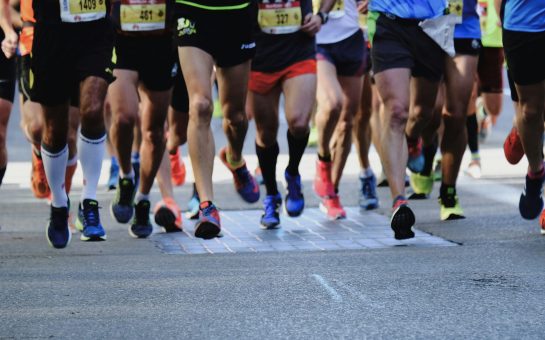“The worst one I came across was a body, found in the basement of a Berlin building at 5 o’clock in the morning, wrapped in a blanket which was leaking out like a sponge.
“The smell was really bad.”
Warning: graphic images are below.
This was the stomach-churning response 50-year-old Buddhist and Manchester Metropolitan University lecturer Sue Fox gave when asked about the worst corpse encounter she experienced a few years ago.
But this isn’t the only meeting mum-of-one Sue has had with the dead.
The media lecturer gained unprecedented access to Manchester hospital autopsies, mortuaries and crematoria over the course of four years to take haunting ‘taboo’ pictures of the dead for her book Post Mortem.
It was originally published back in 1997 but such was the visceral public reaction to the exhibiting of such images they have languished in folders never to see the light of day… until now.
Manchester Metropolitan University is hosting the Encountering Corpses event which brings together some of the brightest minds in the field.
In addition to a series of lectures the university is also showcasing the Encountering Corpses Art Exhibition where Sue’s images will be seen for the first time in 17 years.
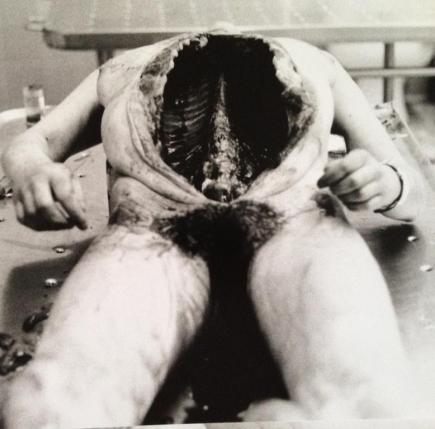
THE SHELL: Sue captures the moment a body has been dissected
There is something of a mystified air surrounding death in the UK with people not wanting to glimpse behind the scenes at the body’s journey to its final resting place.
But what sparked this morbid curiosity in an otherwise carefree artist twenty years ago?
“I was in my twenties and I had never seen a dead body and was really shit scared about it,” she explained.
“I wanted to confront it and experience something quite taboo in society with my studies.
“As an artist I’ve worked alongside doctors – we each depict the anatomy – but it’s partly because I am a Buddhist with the main focus being on the contemplation of impermanence.”
This emotional acceptance that we will die and that our lives as we know it are constantly changing is the main focus of her work which is intrinsically linked to her faith.
Sue sent a request to the top Manchester pathologist explaining her research and requesting access to autopsies, she was subsequently welcomed into the examination room.
Here she examined, reflected and photographed hundreds of cadavers ensuring no identifiable features such as tattoos, birth marks or the face were shown.
This unique body of work, where pictures were interspersed with blank pages on which the reader could reflect and jot down their thoughts, will be on display from the end of this month for the first time in almost 20 years.
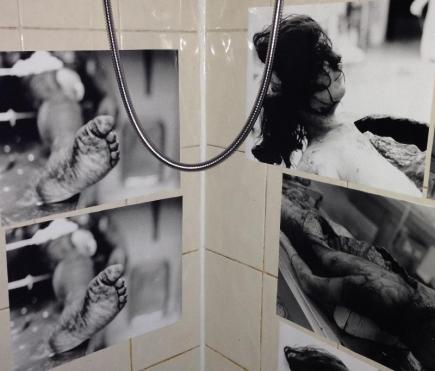
ENCOUNTERING CORPSES: Sue snapped pics over four years
This desire to document the dead in photographic form may make some modern audiences feel uneasy but post-mortem photography was standard procedure in the Victorian era.
Living relatives often posed next to the body to give the appearance that the subject was still alive.
The Tibetan and Parsi funerary practice of sky burials, where bodies are chopped into pieces and left out for vultures to feed on, is another ritual that fascinates Sue.
“Monks sit with dead bodies littered around them and very often they go mad. Unless you’ve got a really positive side to yourself it’s quite depressing watching the body break back down.
“I have a massive curiousity – I’m like a ten-year old! I find everything really fascinating including life, death and sex. I want to know the ins and outs of it all.”
A similar albeit spiritual practice is Chod in which practitioners, in their minds, break up their bodies and offer them up to deities.
Sue explained: “A colleague of mine is from India. Such is the taboo in some villages about this that if you’re caught talking about it or doing it you could be beheaded.
“It’s a spiritual practice and my work represents that.”
But Sue wasn’t always as fearless at delving into the world of the dead recalling the first time she stepped a welly-clad foot inside a post-mortem examination room.
She revealed: “I approached the body with trepidation and awe. The person I saw was a Turkish lorry driver who had jack-knifed, went down an embankment and landed in a river.
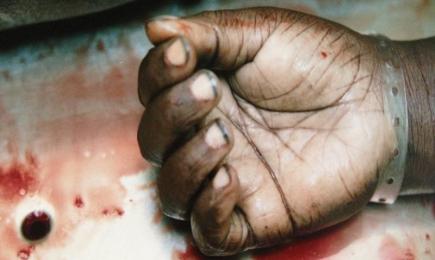
CONTROVERSIAL: Sue’s work has had mixed reactions
“He was there for ages – his whole body was water-logged and very pale. His skin all over was exactly like when you’ve been in the bath for too long.
“He was sliced open and I could see some of the organs bulging out and they were really bright colours. They almost didn’t seem real; it was like they were plastic.”
Not content with merely witnessing such procedures and documenting them for her book Post Mortem, Sue wanted a multi-sensory experience.
“I was picking up organs, putting my hands inside bodies. I wanted to see, feel and smell death,” she explained.
All the corpses she has encountered have been used as part of research and as much as the mortuary visits over the four years have fascinated her, equally there have times when it’s proved to be very upsetting.
“When they brought out bodies of very pre-term babies it was really extreme and profound,” she explained.
“At the time I wanted to get pregnant with my partner, this was before my daughter was born, and had spent a good few years trying.
“When looking at these bodies I was lamenting something that I thought could never be.
“This again was a Buddhist practice of contemplating something that happened to me.”
The artist and university lecturer, who has a self-confessed fascination with bodies, death and sex, explained that after hanging up her lab coat at the end of her visits she would embark on a specific routine when she got home.
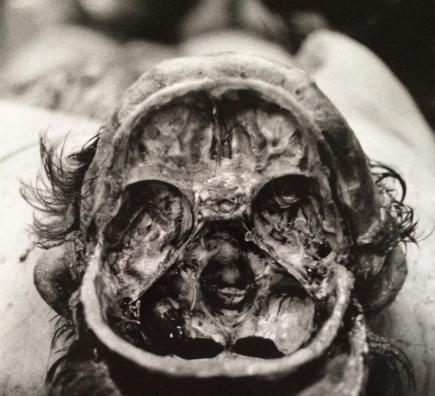
DEATH MASK: Sue had unparalleled access to Manchester mortuaries
“Every time I came away from a mortuary or hospital I would leave in a daze as everything on the street would be alive and moving.
“I did a ritualistic thing when I got home and washed everything including my shoes even though I had my wellies on.
“I felt the energy from them (the corpses) and wanted to fast and meditate on what I saw.”
Controversial German anatomist Gunther von Hagens, who invented plastination and created the world-famous Body Worlds exhibition, is someone Sue admires and has shared work with in the past.
“Like him I’m intrigued by the body,” she explained. “We both want to demystify and educate.
“I went to his Body Worlds exhibition and it was really inspiring – it really expanded my mind.”
Sue said that the exhibition should be compulsory viewing from young children through to adults.
She explained: “If they (children) saw inside the body which is so beautiful they would want to look after it.
“Being in that exhibition was like being in a stunning building but the building was our own body which awakened an awareness and reverence in people’s minds.”
The only thing that Sue argued the exhibition was unable to recreate was the colours within the body.
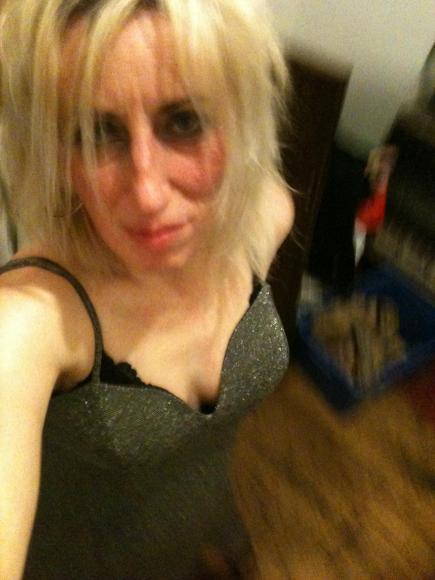
INTRIGUED: Sue is fascinated by the body
She said: “Bodies in mortuaries are absolutely vibrant like jewels. It reminds us that we want to see the body as precious as a jewel and also gives a sense of preciousness of life.
“Young people think they are going to be here forever, they don’t want to contemplate dying. Saying that I would love to be immortal!”
When Sue’s not sharing her insights with students or completing her first novel, she likes to relax in cemeteries.
“I like spending time in cemeteries, although I don’t go every day. I’m kind of excited because there’s a real energy, they are really beautiful places and are really reflective.
“I’m always thinking and evaluating and trying to make sense of things.
The Encountering Corpses Art Exhibition will be held at Sacred Trinity Church in Salford with viewing Monday to Friday from 12pm-4pm.
Weekend viewing is dependent on the church timetable will be listed on the site nearer the time.
For more information click here.
Pictures courtesy of Sue Fox, with thanks


